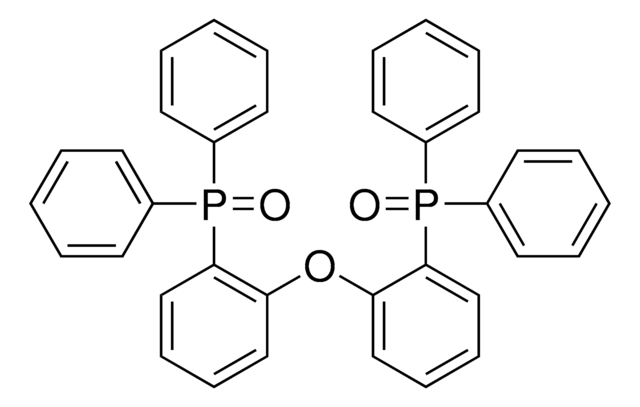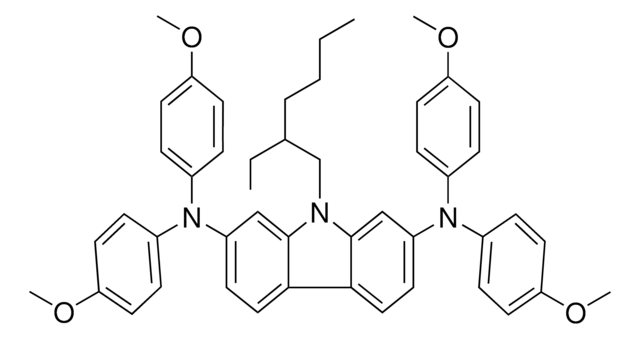Key Documents
907073
PO-T2T
>=99% (HPLC), Mw 909.8 g/mol,
Synonim(y):
(1,3,5-Triazine-2,4,6-triyl)tris(benzene-3,1-diyl)tris(diphenylphosphine oxide), 2,4,6-Tris[3-(diphenylphosphinyl)phenyl]-1,3,5-triazine
About This Item
Polecane produkty
product name
PO-T2T, >=99% (HPLC),
klasa czystości
sublimed grade (>99% (HPLC))
opis
PL-295, 379 nm (in CH2Cl2)
Postać
solid
masa cząsteczkowa
Mw 909.8 g/mol
kolor
white
λmaks.
272 nm in dichloromethane
Energia orbitalna
HOMO -6.8 eV
LUMO -2.8 eV
temp. przechowywania
15-25°C
Zastosowanie
ITO/MoO3 (3 nm)/ TAPC (35 nm)/CBP:TTM-3NCz (3.0 wt%; (40 nm) and CBP:TTM3PCz (3.0 wt%; 25 nm)/B3PYMPM (10 nm)/PO-T2T (70 nm)/LiF (0.8 nm)/Al (100 nm).
The first Tandem, All-exciplex-based WOLED was constructed using PO-T2T for a device structure configured by two parallel blend layers of mCP/PO-T2T and DTAF/PO-T2T, generating blue and yellow exciplex emission, respectively. The resulting device demonstrates for the first time a tandem, all-exciplex-based white-light OLED (WOLED) with excellent efficiencies ηext: 11.6%, ηc: 27.7 cd/A, and ηp: 15.8 ml/W with CIE(0.29, 0.35) and CRI 70.6 that are nearly independent of EL intensity. The tandem architecture and blend-layer donor/acceptor (1:1) configuration are two key elements that fully utilize the exciplex delay fluorescence, providing a paragon for the use of low-cost, abundant organic compounds en route to commercial WOLEDs.
An efficient action of radical-based OLEDs, whose emission originates from a spin doublet, rather than a singlet or triplet exciton was demonstrated in a study published in Nature.
While the emission process is still spin-allowed in these OLEDs, the efficiency limitations imposed by triplet excitons are circumvented for doublets. Using a luminescent radical emitter, an OLED with maximum external quantum efficiency of 27% at a wavelength of 710nm-the highest reported value for deep-red and infrared LEDs was achieved. In this very efficient OLEDs, selective hole injection into the HOMO and electron injection to the SOMO was achieved imploying TAPC as the hole transport layer, and PO-T2T as the electron transport layer to form the fluorescent doublet excited state with near-unity internal quantum efficiency.
Kod klasy składowania
13 - Non Combustible Solids
Klasa zagrożenia wodnego (WGK)
WGK 3
Temperatura zapłonu (°F)
Not applicable
Temperatura zapłonu (°C)
Not applicable
Wybierz jedną z najnowszych wersji:
Certyfikaty analizy (CoA)
Nie widzisz odpowiedniej wersji?
Jeśli potrzebujesz konkretnej wersji, możesz wyszukać konkretny certyfikat według numeru partii lub serii.
Masz już ten produkt?
Dokumenty związane z niedawno zakupionymi produktami zostały zamieszczone w Bibliotece dokumentów.
Produkty
Professor Tokito and Professor Takeda share their new materials, device architecture design principles, and performance optimization protocols for printed and solution-processed, low-cost, highly flexible, organic electronic devices.
Nasz zespół naukowców ma doświadczenie we wszystkich obszarach badań, w tym w naukach przyrodniczych, materiałoznawstwie, syntezie chemicznej, chromatografii, analityce i wielu innych dziedzinach.
Skontaktuj się z zespołem ds. pomocy technicznej








